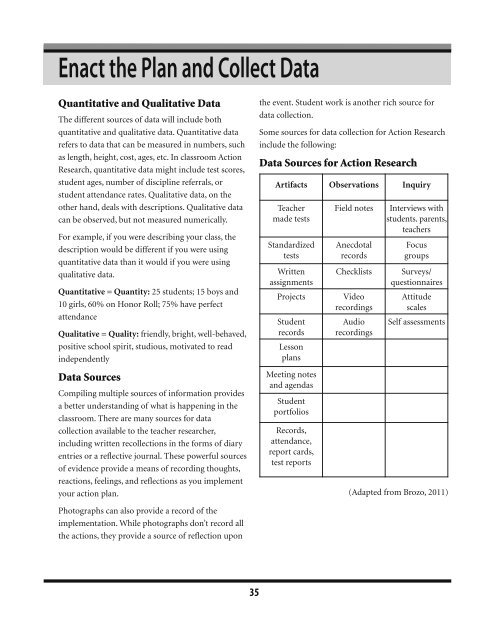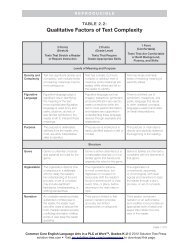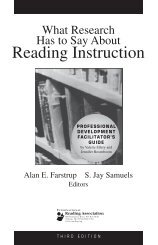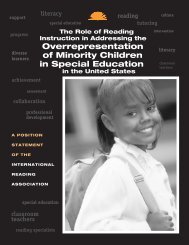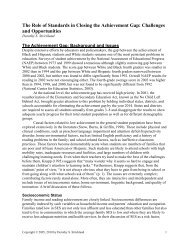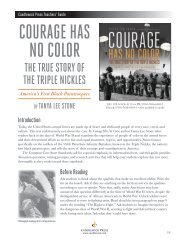A Practical Guide to Action Research for Literacy Educators
A Practical Guide to Action Research for Literacy Educators
A Practical Guide to Action Research for Literacy Educators
Create successful ePaper yourself
Turn your PDF publications into a flip-book with our unique Google optimized e-Paper software.
Enact the Plan and Collect Data<br />
Quantitative and Qualitative Data<br />
The different sources of data will include both<br />
quantitative and qualitative data. Quantitative data<br />
refers <strong>to</strong> data that can be measured in numbers, such<br />
as length, height, cost, ages, etc. In classroom <strong>Action</strong><br />
<strong>Research</strong>, quantitative data might include test scores,<br />
student ages, number of discipline referrals, or<br />
student attendance rates. Qualitative data, on the<br />
other hand, deals with descriptions. Qualitative data<br />
can be observed, but not measured numerically.<br />
For example, if you were describing your class, the<br />
description would be different if you were using<br />
quantitative data than it would if you were using<br />
qualitative data.<br />
Quantitative = Quantity: 25 students; 15 boys and<br />
10 girls, 60% on Honor Roll; 75% have perfect<br />
attendance<br />
Qualitative = Quality: friendly, bright, well-behaved,<br />
positive school spirit, studious, motivated <strong>to</strong> read<br />
independently<br />
Data Sources<br />
Compiling multiple sources of in<strong>for</strong>mation provides<br />
a better understanding of what is happening in the<br />
classroom. There are many sources <strong>for</strong> data<br />
collection available <strong>to</strong> the teacher researcher,<br />
including written recollections in the <strong>for</strong>ms of diary<br />
entries or a reflective journal. These powerful sources<br />
of evidence provide a means of recording thoughts,<br />
reactions, feelings, and reflections as you implement<br />
your action plan.<br />
the event. Student work is another rich source <strong>for</strong><br />
data collection.<br />
Some sources <strong>for</strong> data collection <strong>for</strong> <strong>Action</strong> <strong>Research</strong><br />
include the following:<br />
Data Sources <strong>for</strong> <strong>Action</strong> <strong>Research</strong><br />
Artifacts Observations Inquiry<br />
Teacher<br />
made tests<br />
Standardized<br />
tests<br />
Written<br />
assignments<br />
Projects<br />
Student<br />
records<br />
Lesson<br />
plans<br />
Meeting notes<br />
and agendas<br />
Student<br />
portfolios<br />
Records,<br />
attendance,<br />
report cards,<br />
test reports<br />
v<br />
Field notes<br />
Anecdotal<br />
records<br />
Checklists<br />
Video<br />
recordings<br />
Audio<br />
recordings<br />
Interviews with<br />
students. parents,<br />
teachers<br />
Focus<br />
groups<br />
Surveys/<br />
questionnaires<br />
Attitude<br />
scales<br />
Self assessments<br />
(Adapted from Brozo, 2011)<br />
Pho<strong>to</strong>graphs can also provide a record of the<br />
implementation. While pho<strong>to</strong>graphs don’t record all<br />
the actions, they provide a source of reflection upon<br />
35


